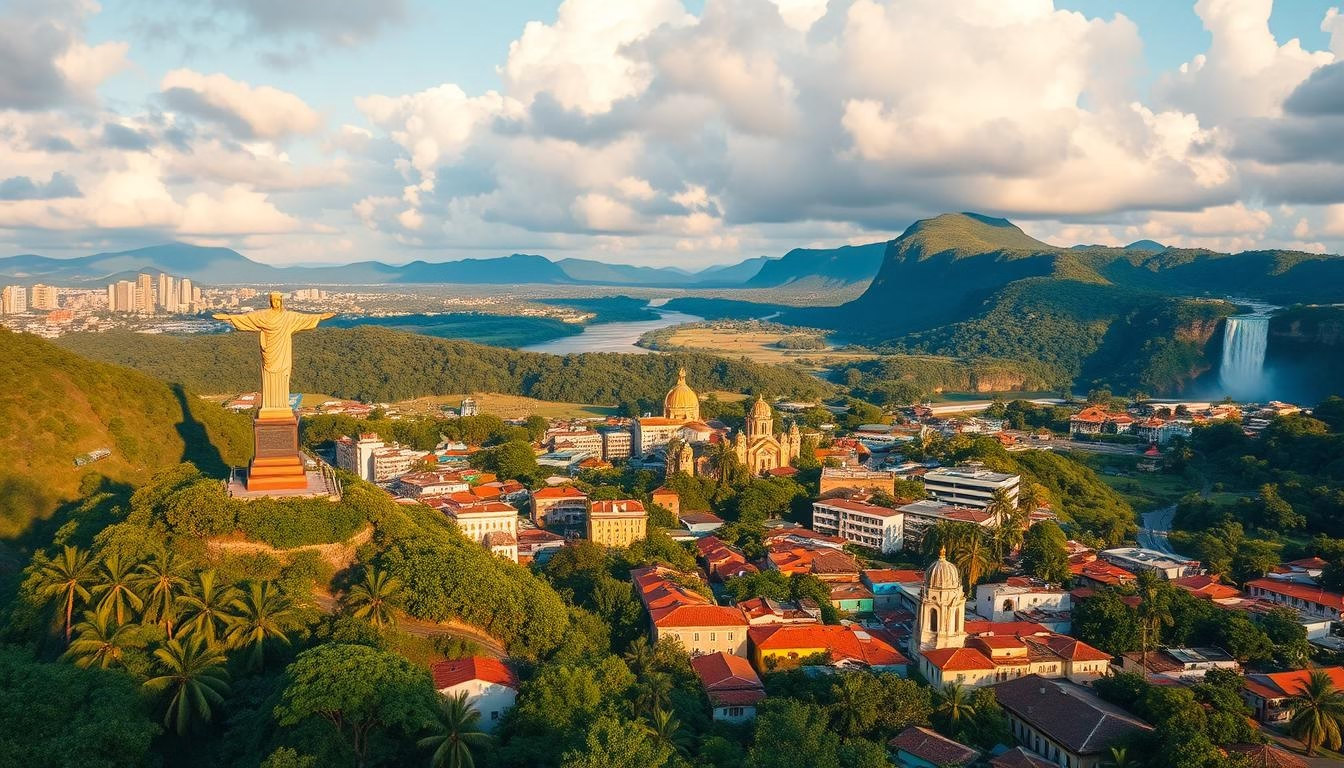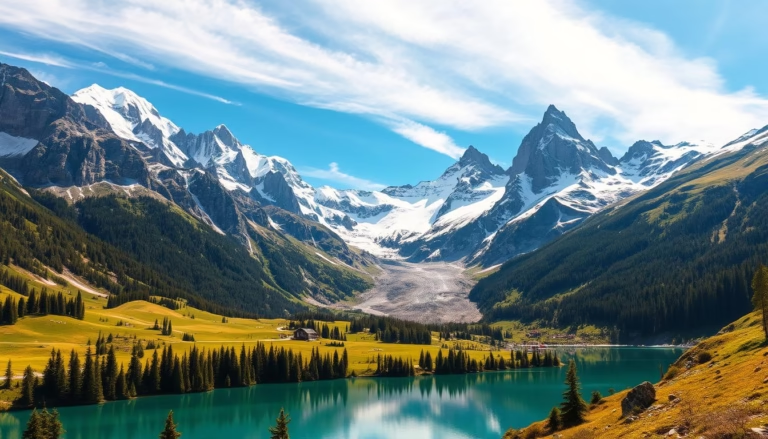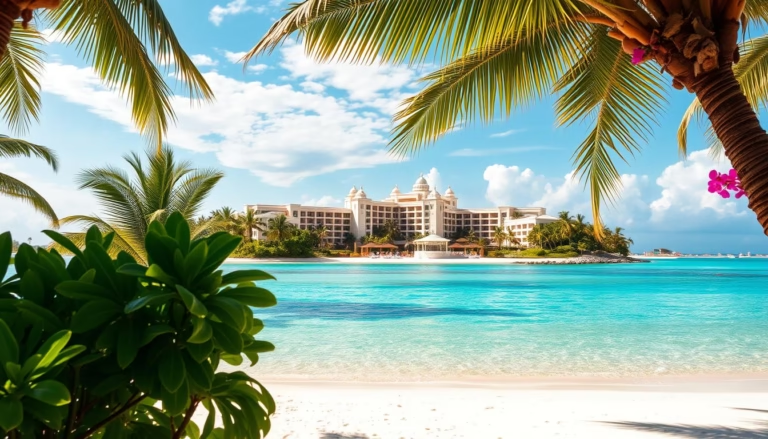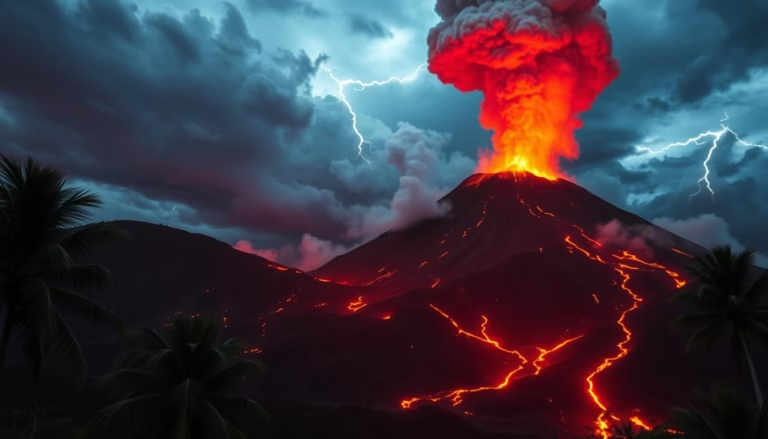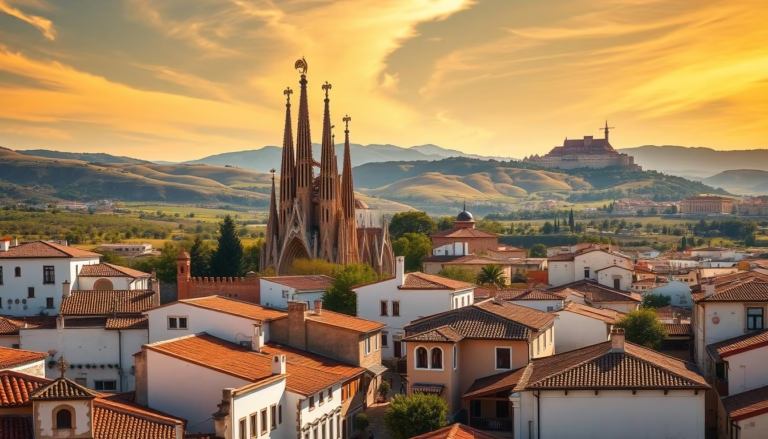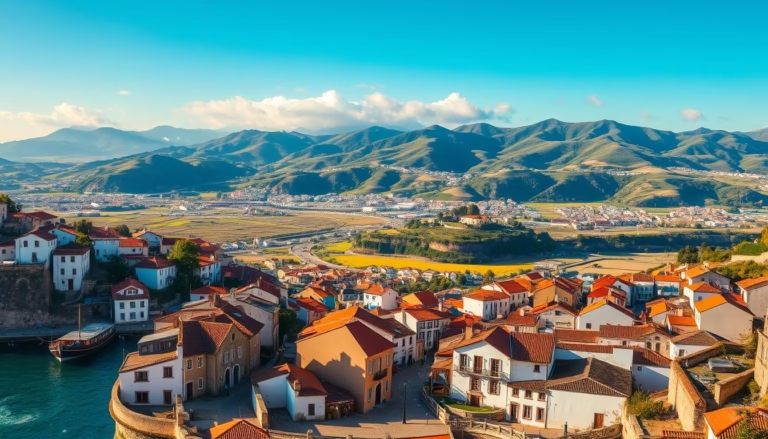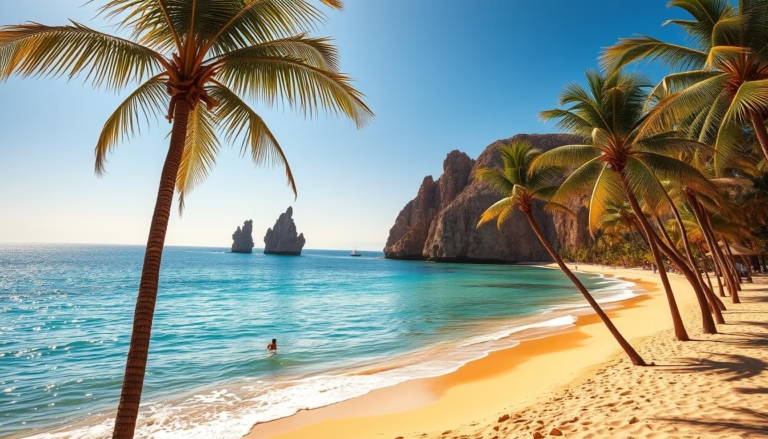Best Places to Visit in Brazil: A Traveler’s Guide
Stretching across nearly half of South America, Brazil offers more than samba rhythms and soccer fever. This vibrant country combines urban energy with untouched wilderness, creating endless possibilities for explorers. From the roaring waters of Iguazu Falls to the quiet magic of colonial towns, every region tells a different story.
You’ll find cities bursting with cultural treasures alongside landscapes that redefine “natural wonder.” The Amazon rainforest – Earth’s largest tropical jungle – shelters unmatched biodiversity. Coastal gems like Jericoacoara Beach reveal golden dunes meeting turquoise waves, while the Pantanal wetlands offer wildlife encounters unlike anywhere else.
What makes this country truly special is its ability to surprise even seasoned travelers. One day you’re marveling at Christ the Redeemer’s outstretched arms over Rio, the next you’re drifting down the Amazon River at sunrise. With so much to experience, planning your journey requires smart choices tailored to your interests.
Key Takeaways
- Fifth-largest nation globally spans diverse ecosystems from rainforests to wetlands
- Features iconic landmarks like Christ the Redeemer and Iguazu Falls
- Combines modern cities with preserved colonial architecture
- Home to 60% of the Amazon rainforest’s biodiversity
- Offers distinct regional cultures across its 26 states
- Requires strategic planning due to its continental size
Introduction: Discovering Brazil’s Diverse Wonders
Imagine a land where golden coastlines melt into emerald jungles, and cities pulse with infectious energy day and night. This is Brazil – a country where every corner offers fresh adventures. Whether you’re drawn to bustling markets in Salvador or quiet canoe rides through flooded forests, your trip will feel like flipping through a storybook of natural and cultural treasures.
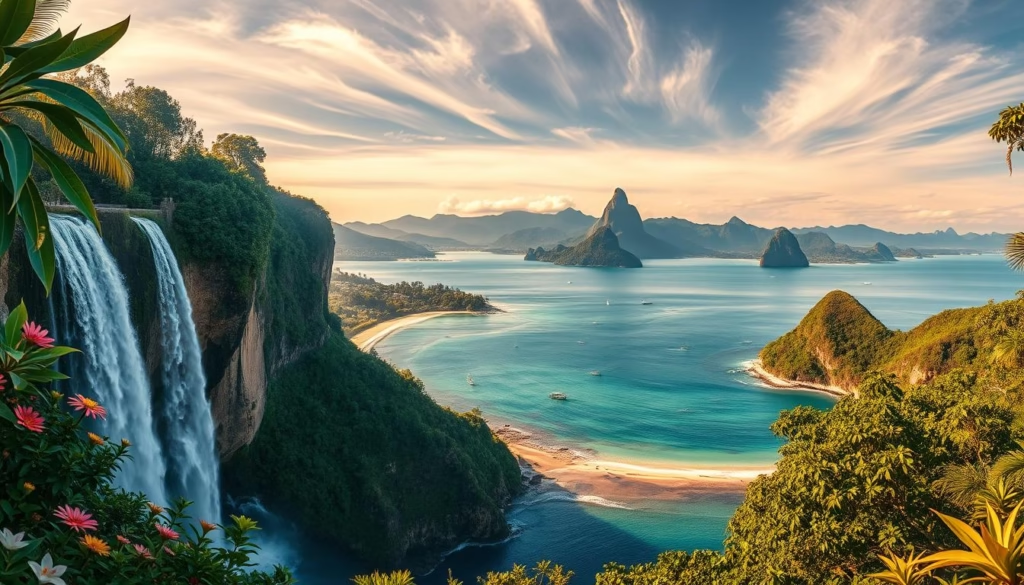
With 3,600 miles of coastline and ecosystems ranging from arid plateaus to misty waterfalls, Brazil’s landscapes demand time. Locals often say, “You don’t visit Brazil – you experience it.” This rings true when dancing in Olinda’s street festivals or spotting jaguars in the Pantanal. Each region feels like its own world, shaped by indigenous roots, colonial history, and modern creativity.
Smart planning lets you savor these contrasts without rushing. Focus on 2-3 areas per week: pair Rio’s urban buzz with Ilha Grande’s untouched beaches, or balance Amazon hikes with Belém’s spice markets. Seasonal timing matters too – June brings vibrant São João celebrations, while August offers prime whale-watching near Bahia.
What truly defines this country is its ability to surprise. One morning, you’re sipping freshly pressed açaí berries. By afternoon, you’re scaling red cliffs overlooking crystal lagoons. These moments – spontaneous and unforgettable – are why travelers return year after year, always discovering new places to love.
Exploring Rio de Janeiro: Iconic Landmarks and Carnival Vibes
Where samba rhythms echo through streets lined with natural wonders, Rio captivates. This city blends postcard-perfect landmarks with infectious energy, creating moments that linger long after you leave. From sunrise at Christ the Redeemer to moonlit parties on golden sands, every experience here feels larger than life.
Christ the Redeemer and Sugarloaf Mountain
The 98-foot Christ the Redeemer statue watches over the city from Mount Corcovado. Beat the crowds by taking the early train ($8 USD) or joining a guided tour that includes hidden viewpoints. Across the bay, Sugarloaf Mountain’s cable cars reveal panoramic views – sunset rides transform the sky into a watercolor masterpiece.
Cultural Festivities and Vibrant Beaches
Copacabana’s 2.5-mile stretch of sand pulses with energy day and night. Locals play footvolley while vendors sell chilled coconuts. For artistic flair, the Selarón Steps’ mosaic tiles shine brightest at dawn before crowds arrive. February’s Carnival unleashes the city’s full spirit, with all-night parades featuring dazzling costumes.
Local Tips for a Memorable Visit
Wear comfortable shoes for exploring hilly neighborhoods. Book tours in advance during peak seasons (June-August). “Rio rewards those who embrace spontaneity,” says Marcos Silva, a veteran guide. Try feijoada stew at family-run cafes and save time for quieter beaches like Praia do Secreto.
Island Paradise: The Allure of Ilha Grande
A short boat ride from Rio’s bustle lies Ilha Grande – a car-free sanctuary where rainforests meet deserted coves. This ecological preserve protects over 150 beaches, each more inviting than the last. The island’s strict development rules keep its charm intact, making it feel worlds away from mainland crowds.
Secluded Beaches and Snorkeling Spots
Lopes Mendes Beach steals the show with its mile-long stretch of powdery sand. Reach it via a 2-hour jungle hike or 30-minute boat ride from Abraão village. For crystal-clear water adventures, join a half-day tour visiting Lagoa Azul’s snorkeling bays and Saco do Ceu’s mangrove channels.
Adventurous Hikes and Hidden Waterfalls
The 3.5-hour trek to Pico do Papagaio summit rewards early risers with sunrise panoramas. “Depart by 1 AM with headlamps – watching dawn break over the island is pure magic,” advises local guide Ana Costa. Less strenuous paths lead to Cachoeira de Feiticeira, where a 40-foot waterfall cascades into natural swimming holes.
| Activity | Location | Access | Duration |
|---|---|---|---|
| Beach-Hopping | Lagoa Verde | Speedboat | 4 hours |
| Mountain Hike | Pico do Papagaio | Abraão Trail | 7 hours |
| Waterfall Swim | Cachoeira de Feiticeira | Jungle Path | 2.5 hours |
Pack light shoes for rocky trails and cash for beachside açaí bowls. While day trips from Rio work, staying overnight lets you experience the island’s true rhythm – fishermen heading out at dawn, bioluminescent plankton glowing after dark.
Urban Spotlight: Sao Paulo’s Dynamic Lifestyle
Skyscrapers stretch toward the horizon in South America’s economic powerhouse, where 12 million residents create a city that never sleeps. São Paulo thrives as a cultural mosaic – part financial hub, part open-air gallery, and always buzzing with inventive energy.
Street Art, Museums, and Culinary Delights
Vila Madalena’s Batman Alley explodes with color, its walls rotating fresh murals monthly. Local artists transform ordinary street corners into Instagram-worthy masterpieces. Don’t miss the Sé Cathedral’s neo-Gothic arches housing South America’s largest organ – its 14,000 pipes will give you chills.
Ibirapuera Park serves as the city’s cultural heart. Wander between the Modern Art Museum’s bold exhibits and the Afro-Brazilian Museum’s powerful storytelling. Foodies rejoice at Mercado Municipal, where vendors stack tropical fruits beside stalls serving mortadella sandwiches – a São Paulo staple since 1933.
Soccer, Markets, and Nightlife
Feel the stadiums shake during Corinthians matches, or explore Pacaembu’s Football Museum ($4 entry). “Here, soccer isn’t just sport – it’s our shared language,” says curator Maria Fernandes. As night falls, head to Mirante Sesc’s free 17th-floor viewpoint. Sip Brazilian coffee while watching the city transform into a galaxy of twinkling lights.
Paulista Avenue comes alive after dark with samba clubs and speakeasies hidden behind unmarked doors. For authentic experiences, join a graffiti tour led by local artists or taste-test three generations of pizza recipes in Bixiga’s Italian quarter.
Historic Trails: The Timeless Beauty of Ouro Preto
Nestled in Brazil’s mineral-rich highlands, Ouro Preto stands as a living museum of baroque splendor. This former mining town whispers tales of 18th-century wealth through its gilded churches and winding streets that cling to steep hillsides. Unlike modern cities, every corner here reveals intricate stonework and echoes of colonial ambition.
Gold Rush Legacy in Stone and Gold
At its peak, Ouro Preto produced 1,200 tons of gold – enough to build 20 churches dripping with golden details. The Church of St. Francis of Assisi showcases Aleijadinho’s genius, its soapstone carvings telling stories of faith and human struggle. Local guides often note: “The gold on these altars came from enslaved hands, but the art transcends its painful origins.”
Walking Through Living History
Rubber-soled shoes prove essential for navigating the town’s uneven cobblestones. These streets lead to hidden gems like Tiradentes Square, where locals sell hand-carved soapstone figurines. The free Museu da Inconfidencia reveals Brazil’s independence movement through maps and artifacts – a must-see before joining exploring Ouro Preto’s colonial heart by rail.
| Historic Site | Feature | Visitor Tip |
|---|---|---|
| Matriz de Nossa Senhora | 1.7 tons of gold leaf | Visit before noon for best light |
| Mina du Veloso | Old gold mine tunnels | Wear closed-toe shoes |
| Casa dos Contos | 18th-century mint | Free guided tours Tuesdays |
Morning mist clinging to church spires creates magical photo opportunities. As artisan Maria Fernandes shares while polishing quartz: “Our town isn’t frozen in time – we keep traditions alive through craft.” Evening brings guitar melodies drifting from family-run restaurants serving feijão tropeiro stew.
Charming Heritage: Paraty’s Cobblestone Streets
Time seems to pause in Paraty, where 18th-century charm meets coastal splendor. This town became a UNESCO World Heritage Site by preserving its gold-rush-era soul – think horse-drawn carts clattering over rounded stones and church bells echoing through candy-colored alleys. Sandwiched between emerald mountains and sapphire bays, it’s a living postcard of Brazil’s colonial past.
UNESCO World Heritage and Colonial Vibes
Paraty’s cobblestone streets tell stories of mule trains carrying gold to waiting ships. The historic center’s whitewashed buildings with bold blue trim remain nearly unchanged since 1700. “We polish our door knockers like our ancestors polished silver,” shares local historian Carlos Mendes while leading walking tours past baroque churches.
| Activity | Location | Tip |
|---|---|---|
| Historic Walk | Rua do Comércio | Wear flat shoes for stones |
| Festival Visit | FLIP Main Tent | Book tickets 3 months early |
| Cachaça Tasting | Engenho D’Ouro | Try honey-infused varieties |
Scenic Bays and Mountain Backdrops
Beyond the town, 65 islands dot waters so clear you’ll spot starfish from your kayak. Local guides recommend sunrise paddles through Saco de Mamanguá’s mangrove tunnels. Hikers find hidden waterfalls in the Serra da Bocaina foothills – pack quick-dry clothes for sudden tropical showers.
June brings jazz melodies floating over the bay, while August’s cachaça festivals turn the coast into a celebration of Brazil’s national spirit. Whether exploring by land or water, Paraty’s magic lies in its ability to bridge centuries of history with vibrant modern culture.
Jungle Journeys: The Amazon Rainforest Experience
Deep within the world’s largest tropical rainforest, life thrives in every shadow and sunbeam. This living labyrinth spans nine countries, but its Brazilian region offers unmatched access to flooded forests and rare wildlife. Morning canoe rides reveal scarlet macaws darting through canopy gaps, while night walks uncover tarantulas glowing under UV lights.
Exploring Manaus and Wildlife Adventures
Manaus serves as the gateway to Amazonian wonders. The Meeting of Waters – where dark Rio Negro clashes with muddy Solimões – creates a natural phenomenon visible on tour boat excursions. Local guides share secrets like spotting pink river dolphins at dawn or identifying medicinal plants used by indigenous communities for centuries.
Guided Tours and Eco-Lodges
Responsible travel thrives through eco-certified operators offering multi-day jungle immersions. Sleep in treehouse lodges listening to howler monkeys, or join researchers tracking giant otters. “Choose tours supporting local villages,” advises biologist Luiza Costa. “Your visit helps protect this vital region while creating unforgettable encounters with wildlife.”
